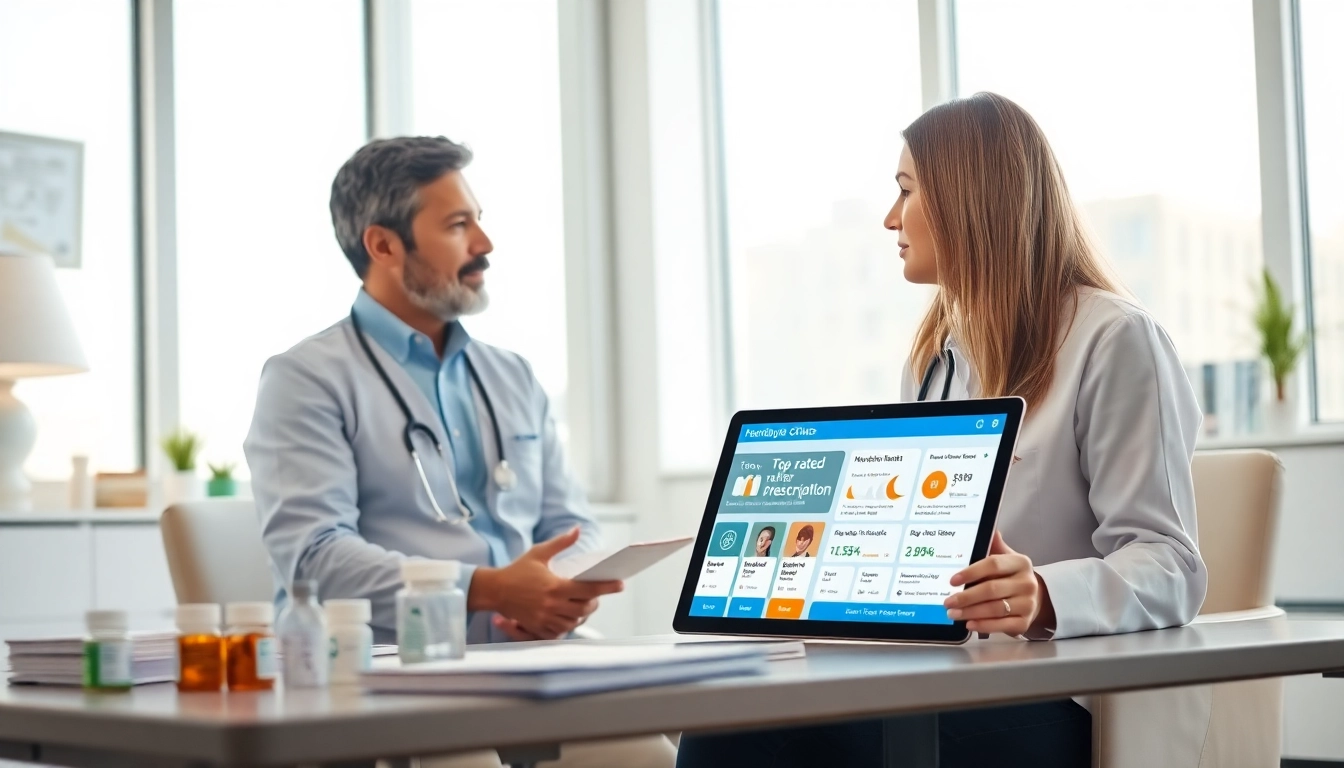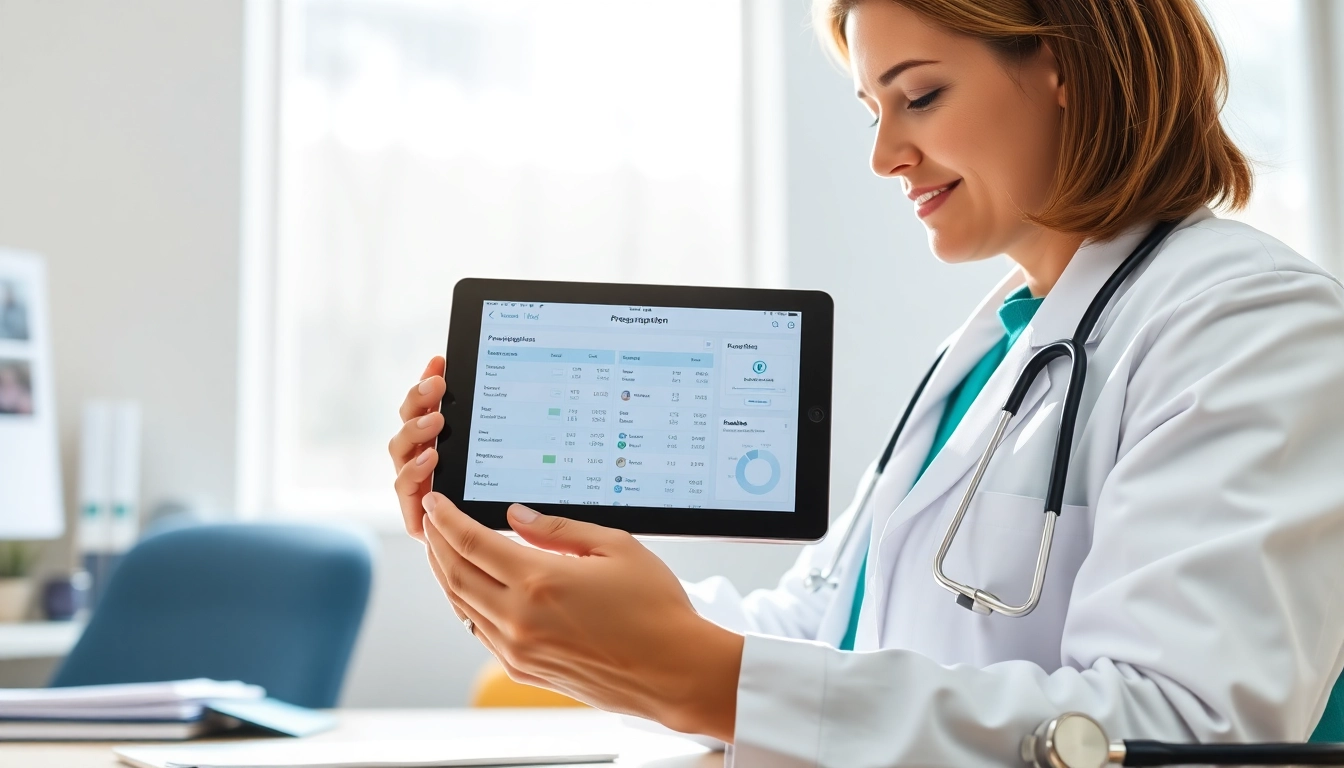Understanding E-Prescribing Software
What is E-Prescribing Software?
E-prescribing software is a powerful digital tool that enables healthcare providers to electronically send prescriptions to pharmacies. This form of prescribing replaces the traditional paper-based method with a more streamlined and accurate system. At its core, e-prescribing improves the way healthcare professionals manage medications, making it easier to create, access, and transmit prescriptions securely from the point-of-care. The transition from paper to digital not only enhances efficiency but also significantly contributes to patient safety by minimizing errors often associated with handwritten prescriptions.
Benefits of E-Prescribing for Healthcare Providers
Implementing e-prescribing software offers myriad advantages for healthcare providers. First and foremost, it reduces the incidence of medication errors, enhancing patient safety. By allowing prescribers to access comprehensive patient medication histories and allergy information, healthcare providers can make informed decisions based on full patient profiles.
Moreover, e-prescribing expedites the prescription process, allowing for quicker patient turnaround times, which ultimately enhances patient satisfaction. It streamlines workflows, reduces the workload in busy practices, and most importantly, helps ensure that patients receive their medications promptly. An added benefit is its cost-effectiveness. By minimizing the amount of time spent on prescription management, practices can enhance their operational efficiency and improve cash flow.
Common Misconceptions about E-Prescribing Software
Despite its clear benefits, several misconceptions about e-prescribing software persist in the healthcare industry. One prevalent myth is that e-prescribing eliminates the need for personal patient-pharmacist interactions. In reality, e-prescribing fosters improved communication, enabling pharmacists to address any clarifications regarding prescriptions while still enhancing their role as medication advisors.
Another misconception is the notion that e-prescribing systems are overly complex and difficult to learn. Today’s e-prescribing solutions are designed with user-friendly interfaces that prioritize simplicity, enabling practitioners to adopt them quickly without extensive training. Understanding these tools is fundamental for healthcare providers eager to leverage technology for improved patient care.
Essential Features of E-Prescribing Software
User-Friendly Dashboards for Providers
A key feature of e-prescribing software is its intuitive dashboard interface that centralizes medication management tasks. These dashboards allow providers to view all pending prescriptions, medication histories, and patient information in one place. By having a consolidated view, prescribers can effectively manage their daily workflows without undue complexity.
Additionally, customizable dashboards can reflect individual workflows, ensuring each provider can tailor the interface to their practice’s needs. This personalization reduces time spent navigating through unnecessary information, optimizing efficiency and accuracy in prescription management.
Medication and Allergy Management Tools
Another essential feature of e-prescribing software is its robust medication and allergy management tools. These tools assist healthcare providers in documenting patient allergies and current medications, offering vital information that informs prescribing decisions. Access to this data is critical for minimizing adverse drug events and optimizing treatment outcomes.
Furthermore, many e-prescribing systems integrate alerts that notify providers of potential allergy conflicts or interactions with prescribed medications. By promoting vigilant practices, such features ensure that providers can avoid harmful prescribing errors, thereby enhancing patient safety.
Automated Prescription Tracking and Refills
Automated prescription tracking is another transformative feature of e-prescribing software. The ability to track prescriptions in real-time allows healthcare providers to monitor their patients’ medication adherence and refill statuses successfully. If a patient requires a refill, providers can facilitate this process electronically, minimizing the wait time that traditionally encumbered prescription renewals.
This automated system not only fosters patient independence but also reduces the workload on staff who would otherwise manage refill requests manually. It improves operational efficiency, ultimately leading to better patient outcomes through timely access to medications.
Advanced Features of E-Prescribing Software
Medication Decision Support Systems
Medication decision support systems (MDSS) are an advanced feature that provides prescribers with clinical guidelines and evidence-based recommendations while prescribing. These systems analyze patient data and facilitate informed decision-making by highlighting potential drug interactions, contraindications, and alternative therapies. With integrated MDSS, healthcare providers can confidently prescribe the safest and most effective medications, aligning with best medical practices.
The incorporation of MDSS in e-prescribing software enhances clinical decision-making by helping minimize adverse drug events and ensuring better adherence to treatment protocols. This feature plays a crucial role in elevating the quality of patient care.
Drug Interaction Alerts and Safety Checks
The implementation of drug interaction alerts and safety checks within e-prescribing systems is vital for patient safety. These features continuously analyze prescribed medications against known interactions and provide immediate alerts to prescribers about potential issues. With real-time notifications, providers can re-evaluate treatment plans or make prompt adjustments, ensuring that patients receive the best possible care.
Moreover, this functionality alleviates the risk of unintended medication complications, empowering providers to engage in safer prescribing practices. These safety checks enhance the healthcare team’s confidence in the medications they prescribe while reinforcing the principles of evidence-based medicine.
Integration with EHR Systems
A significant advantage of e-prescribing software is its seamless integration with electronic health records (EHRs). This interoperability allows healthcare providers to access comprehensive patient information in real-time, including medical histories, test results, and existing medication lists. By leveraging EHR integration, e-prescribing systems improve communication between providers, ultimately encouraging collaborative care.
Additionally, integrated systems streamline the workflow, enabling providers to efficiently handle documentation processes while maintaining complete visibility of the patient’s healthcare journey. This improved connectivity among various healthcare platforms is pivotal in enhancing patient care quality.
Choosing the Right E-Prescribing Software
Assessing Functionality vs. Usability
When considering e-prescribing software, healthcare providers must strike a balance between functionality and usability. While a system may offer an extensive suite of features, it is essential to evaluate whether it is user-friendly and enhances operational efficiency. The ideal solution should seamlessly integrate necessary functionalities that cater to the unique needs of a practice while maintaining an engaging user interface.
To make an informed decision, it may be beneficial to solicit opinions from current users and conduct a thorough evaluation of available demos. A system that marries high functionality with intuitive usability ultimately ensures greater adoption and efficacy within practices.
Cost-Effectiveness and Return on Investment
Cost-effectiveness is a critical consideration when choosing e-prescribing software. Initial investment costs can vary significantly among different systems, and understanding the potential return on investment is essential for evaluating overall value. Healthcare providers should look for solutions that offer transparent pricing structures, along with the assurance of long-term savings through heightened efficiency and reduced administrative burdens.
Through automation and improved management of prescriptions, practices can witness a positive impact on revenue cycle management, leading to increased profitability. Assessing long-term cost benefits in tandem with quality improvements will help inform decision-making regarding e-prescribing systems.
Reviewing User Feedback and Ratings
Before selecting an e-prescribing software solution, it is prudent to review user feedback and ratings. Collecting insights from current users offers valuable perspectives on the software’s performance, strengths, and weaknesses. Platforms that aggregate reviews and ratings can help potential users gauge satisfaction levels and overall functionality based on real-world applications.
Moreover, engaging directly with users through forums or industry events can provide firsthand accounts of user experiences, fostering informed decision-making and ensuring the selected software aligns with practice needs and expectations.
Implementing E-Prescribing Software in Practice
Steps for Seamless Integration
Implementing e-prescribing software requires a structured approach to ensure seamless integration into existing workflows. The initial step involves evaluating current systems and defining specific objectives that the new software should address. Establishing clear goals will guide the selection and customization of e-prescribing solutions.
Following this evaluation, engaging all stakeholders, including healthcare teams and administrative staff, in training and onboarding processes is crucial. A well-defined implementation plan will support a smoother transition and enhance adoption rates across the entire office.
Training Staff and Ensuring Compliance
The successful deployment of e-prescribing software hinges on proper training and staff compliance. Developing comprehensive training programs ensures that all users understand the software’s features, functionalities, and best practices. Scheduled refresher training and ongoing support should be part of the training strategy to encourage continued growth in proficiency and address any emerging issues with the system.
In addition, ensuring compliance with healthcare regulations and software protocols is paramount for safeguarding patient information and maintaining high standards of care. Establishing a culture of accountability and continuous improvement within the practice can facilitate adherence to e-prescribing software requirements.
Measuring Success and Performance Metrics
Quantifying the success of e-prescribing software adoption is essential for validating its impact on practice efficiency and patient care. Providers should determine key performance metrics to track improvements, such as reductions in prescription errors, enhanced medication adherence, and elevated patient satisfaction scores. features of eprescribing software can significantly contribute to these outcomes when utilized effectively.
Regularly assessing these metrics allows healthcare providers to identify areas for improvement and optimize their use of e-prescribing software, ensuring that practices continue to evolve and adapt to meet patient needs.













Leave a Reply